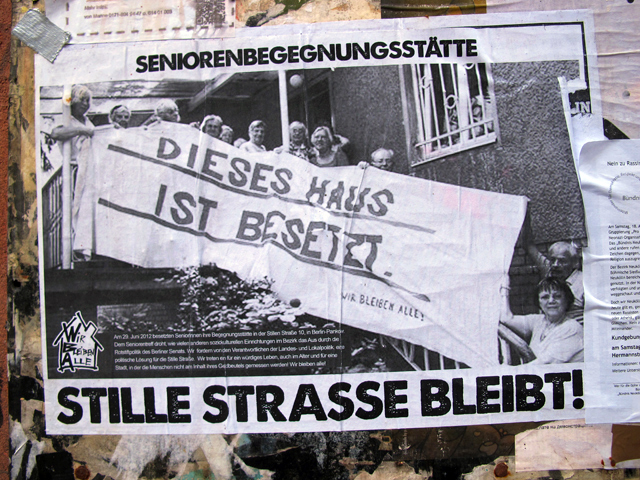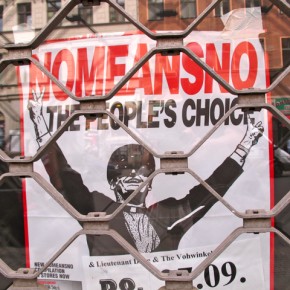At first glance, the flyer might have struck the jaded flâneur as parody. Instead of the crusty punks and hippies that usually festoon images of protest in Berlin, a bunch of white-hairs hold a large banner with the classic squatter’s slogan “This house is occupied.” And even though the header is strictly informative — “Senior citizen community center” — the fact that it comprises a single word makes it perfectly suited for the sort of double-meaning that rock bands favor when choosing a name.
But this is no irony-saturated album cover. The photograph documents a public show of solidarity by a group of senior citizens. Residents of the eastern portion of Berlin who passed much of their adult lives under the German Democratic Republic’s iron rule, they joined together to fight the insidious advance of gentrification threatening to exile them from their longtime home. The fine print explains:
“On June 29th, senior citizens occupied their community center at 10 Stille Straße in Berlin’s Pankow neighborhood. This meeting place for seniors, like many other socio-cultural establishments in the district, is threatened with elimination by the red pen politics of the Berlin Senate. We demand of the responsible parties in regional and local politics a political solution for Stille Straße. We come forward for a life of dignity, even in old age, and for a city, in which people aren’t measured by the content of their wallets! We’ll all stay!”
That last line, echoed in the catchy house graphic on the bottom left of the flyer, communicates the fundamental tenet of the squatting movement: refuse to be displaced. In a way, this declaration of tenaciousness makes even more sense coming from this demographic, since they have typically lived in their communities the longest.
For those of us who live outside of the hotbed of radicalism that Berlin has been for a century, it is important to discern the relationship between this unlikely action and the sort of thing the Occupy movement started doing once it had passed the point where simply showing up at a public gathering sufficed as a political gesture.
In fighting the home evictions that have swept the United States (and other countries, to a less obvious extent) since 2008, the movement understandably focused on the plight of senior citizens. Trying to get by on fixed incomes and often the victim of predatory lenders that had convinced them to refinance their homes under unfavorable terms, elderly people worked very nicely in their role as rhetorical standard-bearers for the 99%.
The situation of these Berlin seniors was rather different, given the context. They had expected to collect the standard retirees’ pension dispensed by East Germany’s communist government. Forced to adapt to more uncertain conditions in the post-unification West, they eventually found themselves challenged by the same trends, broadly speaking, that inspired Occupy Wall Street: a widening gap between the well-off and everyone else and the intuition that the so-called 1% would stop at nothing in the ruthless pursuit of more private Lebensraum.
It is worth noting that, unlike the majority of squat-related protests, this one actually led to a political victory, with Berlin officials recently agreeing to let the community center continue at its current location. Also noteworthy is the fact that, as this article in The Guardian details, the building in which this community center is housed once belonged to the head of East Germany’s feared Stasi secret police.
Preface and translation from the German by Charlie Bertsch. Photographed in Berlin by Joel Schalit.





